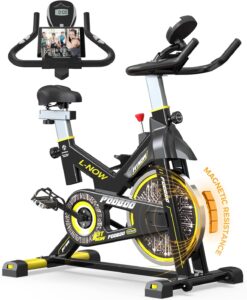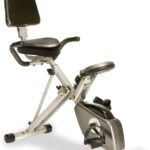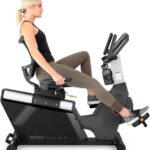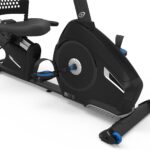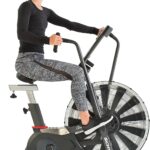Exercise bikes are now a big trend in fitness. They’re popular because they’re simple to use and effective for staying in shape. But choosing the right bike is important. One big choice is between a Magnetic vs Belt Drive system. These terms might sound fancy, but they matter. They decide how your bike ride feels and the sound it makes.
This guide will help you understand these two systems in easy words. Knowing this will help you decide the best bike for you, whether you want quiet morning rides or intense workout sessions. Let’s learn together!
The major difference between the Magnetic Vs Belt Drive exercise bike system
Magnetic Drive System
Consider two magnets attempting to make contact. They will attract if they are opposite poles and push away or repel if they are the same. Apply this fundamental science to exercise bikes. The Magnetic Drive System employs magnets to generate a force known as resistance, which makes your pedals more difficult to push.
When you change the resistance level on a magnetic exercise bike, you move these magnets closer or farther away from the flywheel. The closer the magnets are, the more difficult it is to cycle, resulting in a more intense workout. Pedaling gets easier when they are farther apart, resulting in a lighter exercise session.
Advantages of Magnetic Resistance
- Quiet Operation: One of the most loved features of magnetic resistance is its silent performance. Unlike other types, magnetic drive bikes don’t produce much noise, making them perfect for home use, especially if you don’t want to disturb others.
- Smooth and Consistent Resistance: You get a very even resistance with magnets in play. This ensures your ride is smooth, without sudden jerks or changes, benefiting those who prefer a consistent training rhythm.
- Less Wear and Tear: Magnetic systems have fewer moving parts. That means less friction and less friction means longer life for the bike. It’s a win-win!
Disadvantages of Magnetic Resistance
- Cost Implications: Quality often comes at a price. With their advanced features, magnetic drive exercise bikes can be more expensive than their counterparts. But many believe the benefits outweigh the costs.
- Weight and Bulkiness: Some magnetic resistance bikes can be heavier and bulkier. This might be a consideration if you have limited space or plan to move your bike often.
Belt Drive System
Have you ever seen a conveyor belt transporting things in a factory or an airport? Or maybe you’ve spotted the rubber belt in your car’s engine. The Belt Drive System in exercise bikes operates similarly. The pedals are connected to the flywheel by a strong, rubberized belt, which causes the bike to move. When you pedal, the belt turns the flywheel, giving you a workout.
The simplicity of the belt mechanism is its beauty. It has a simple design with fewer parts, which means there is less that can go wrong.
Advantages of Belt Drive
- Minimal Maintenance: Unlike chains that need regular oiling and tension adjustments, belt drives remain fuss-free. They’re designed to last long without the need for constant care.
- Quietness: A standout feature of the belt drive is its whisper-quiet operation. Whether you’re watching a movie or listening to soothing tunes, the noise from the bike won’t overshadow your experience.
- Authentic Cycling Feel: For those who love the feel of an outdoor bike, the belt drive system comes close. It gives a natural, seamless cycling sensation that many users adore.
Disadvantages of Belt Drive
- Potential Belt Replacements: Over time and with heavy usage, the belt might stretch out or wear. When this happens, it will need a replacement, which might not always be a straightforward process.
- Limited Resistance Levels: Some belt-driven bikes might offer fewer resistance levels compared to magnetic ones. This might be a factor for advanced users who desire varied intensity in their workouts.
Read: How Do Exercise Bikes Calculate Calories
Comparing Magnetic Vs Belt Drive Exercise bike
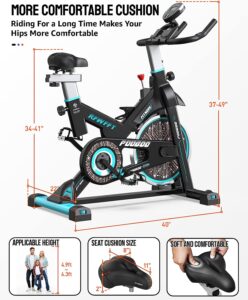
Longevity and durability
When purchasing an exercise bike, you want something that will last. Magnetic and belt drives are both quite durable. While magnetic bikes have fewer moving components and less friction, belt-driven bikes have a simple design that is built to last. However, belts may require replacement after extensive usage, whereas magnetic systems, by definition, require less regular maintenance.
Maintenance and Care
Belt-drive bikes typically require less frequent maintenance. There is no need to oil the belt; only inspect it regularly to ensure it is in good condition. Magnetic drive systems, while long-lasting, may necessitate periodic inspections to ensure the magnetic resistance mechanism is functioning properly. Overall, both systems are intended to provide exercise enthusiasts with hassle-free experiences.
User Experience and Noise Levels
Both options are winners for folks who want to work out in peace. Because of their frictionless functioning, magnetic systems are inherently quiet. On the other hand, Belt drives promise a silent ride due to the smooth belt mechanism. So, if you want to work out early in the morning or live in an apartment, either option will not bother your neighbors.
Cost Considerations and Value for Money
Price is frequently a deciding factor. Magnetic drive bikes are more expensive due to their complex resistance mechanisms. However, they ensure a more refined exercise experience and increased longevity. Belt-driven bikes, on the other hand, while sometimes less expensive, may incur the additional cost of future belt replacements.
Read: Do exercise bikes have weight limits?
FAQs
1. What’s the main difference between Magnetic vs Belt Drive systems?
Magnetic Drive systems use magnets to create resistance, making pedaling harder or easier. On the other hand, Belt Drive systems use a rubberized belt to turn the flywheel as you pedal, providing a natural cycling feel.
2. Which drive system is quieter: Magnetic or Belt?
Both systems are known for their quiet operation. Magnetic systems have a near-silent, frictionless operation, while Belt Drives offer a smooth, low-noise cycling experience.
3. How often will I need to maintain or repair my exercise bike with these drive systems?
Magnetic drive bikes usually require less frequent maintenance due to fewer moving parts. Belt-drive bikes are also low-maintenance, but the belt might need replacement after extensive use.
4. Are Magnetic Drive bikes more expensive than Belt Drive ones?
Generally, Magnetic Drive bikes can be pricier because of their advanced resistance systems. However, the investment often ensures a refined exercise experience and longevity. Belt-drive bikes might be more affordable upfront, but potential belt replacements could add to long-term costs.
Conclusion
Choosing a Magnetic vs Belt Drive system for your exercise bike is more than mechanics—it’s about matching your fitness journey with the proper technology. Belt Drives provide a true cycling sensation, while Magnetic Drives provide increased resistance and longevity. Both have distinct features that ensure quiet, efficient workouts regardless of whether you choose. Remember that the greatest exercise bike is one that fulfills your specific demands and fits into your lifestyle. Understanding these drive systems can help you decide whether you’re a seasoned cyclist or a fitness novice.
